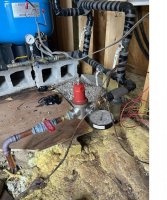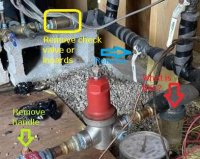As for the check valve, I'd appreciate hearing why I should remove it. Everything I've read said it is important to have it to maintain pressure in the tank. I understand there is a check valve just above the pump, but why not have a second one just before the tank? I see that having one at the tank could mask a leak in the well pipe or a malfunctioning check valve at the pump. I will remove or gut it -- how easy it is to gut it?
The topside check valve was needed with the old galvanized pressure tank, because of the technique of adding air. With the precharged diaphragm pressure tank, that check valve become undesireable.
Having only check valve(s) at the pump keeps the line pressurized, so no contamination can leak in. If there is a topside check valve, and there is a minute leak in the check valve at the pump, you can draw a vacuum in the drop line. Then when the pump turns on, you can get a water hammer as the water hits the topside check valve. On the other hand, if the only check valves are at the pump, the pressure helps seat the poppet better.
There is not universal agreement that you should not have a topside check valve.
A topside check valve will not always cause a problem, and will usually not cause a problem. But on balance, you are better without an above ground check valve. There is one state that requires the top side check valve, and people get along fine usually. Other states forbid the topside check valve. Most states permit either.
I suggest you search for past posts in the well and pump forum. There have been a lot of past discussions on this.
https://terrylove.com/forums/index.php?forums/pumps-and-tanks-well-forum-blog-water-is-life.4/
Here are some:
h
ttps://terrylove.com/forums/index.php?threads/new-old-house-pressure-tank.95738/#post-688396
https://terrylove.com/forums/index....n-pump-and-torque-arrestor.81467/#post-588813 but as you can see on #3 on that post, there are other thoughts.
The check valve can be useful as a work around with a hole in the drop pipe or a failed check valve at the pump.
Check valves can often be disassembled to remove the poppet, turning the housing into connector in the line.


